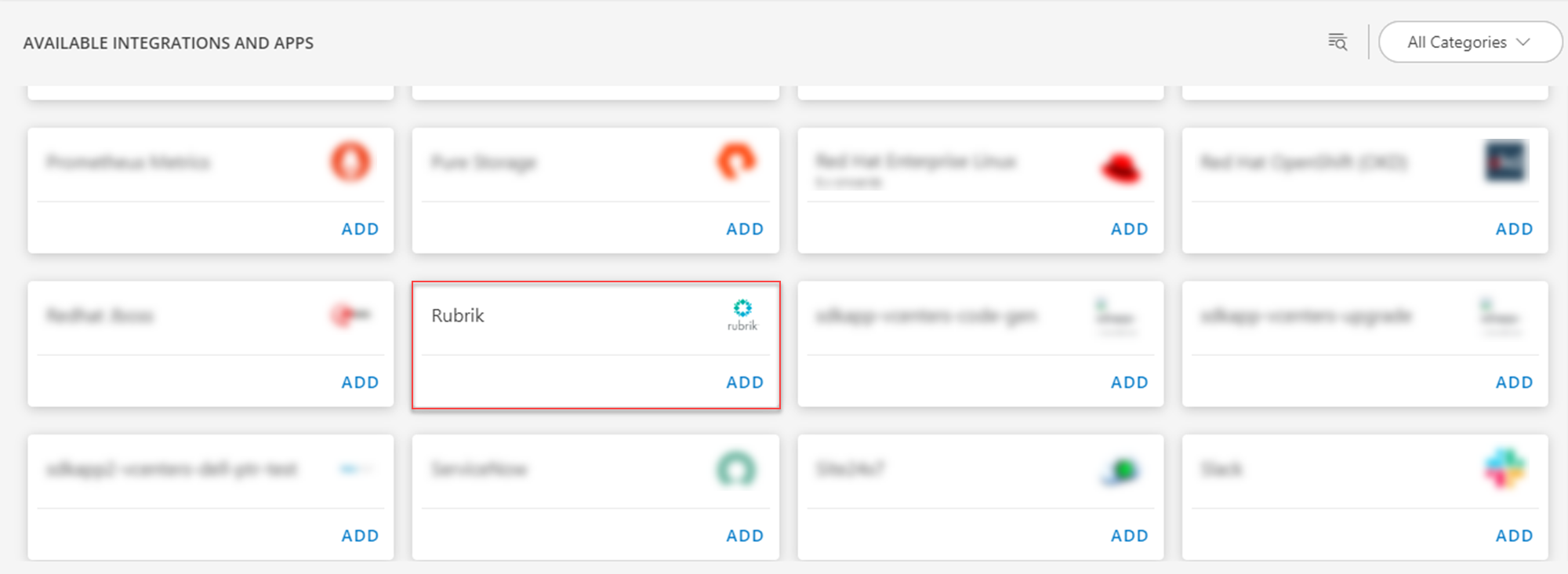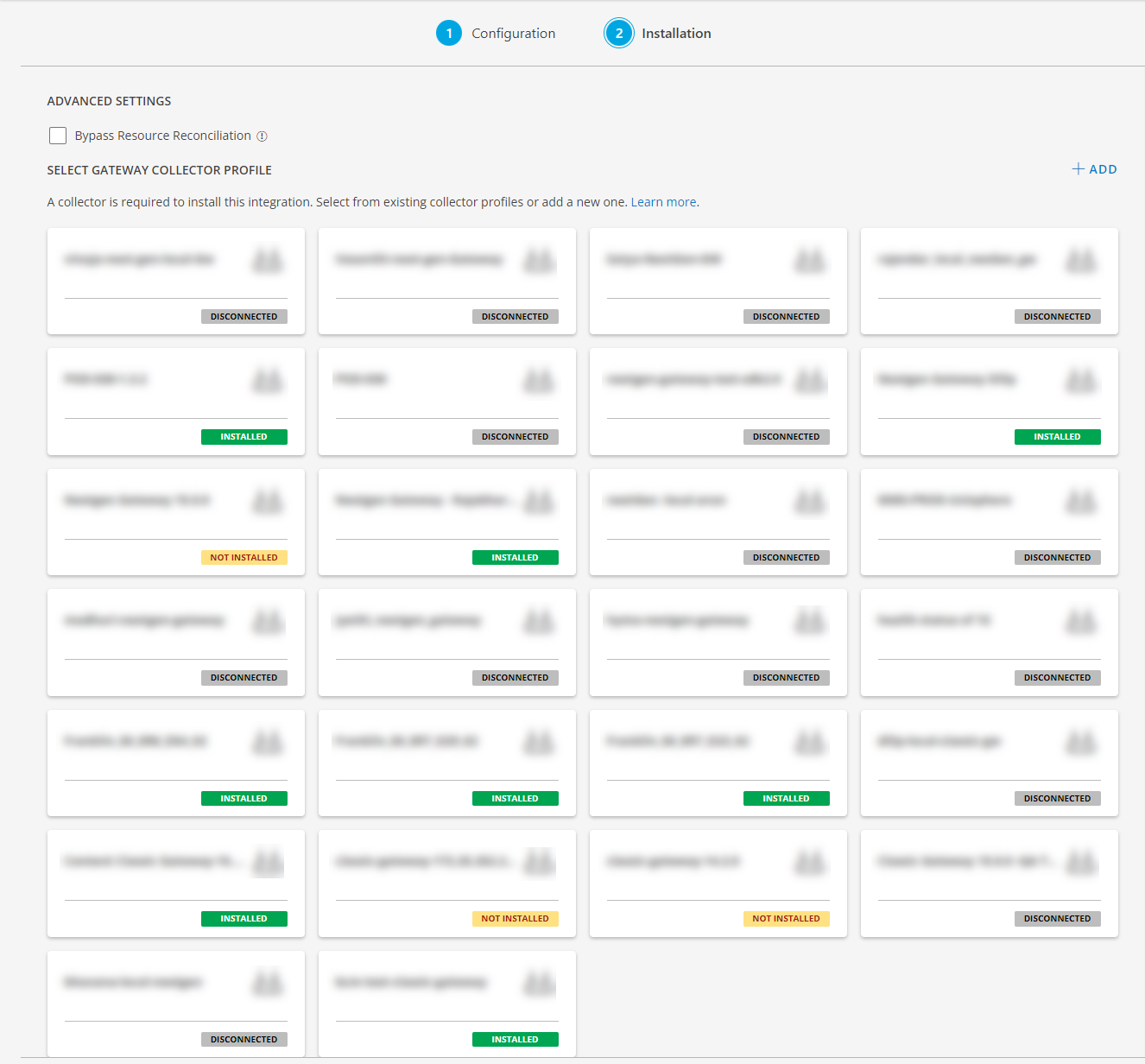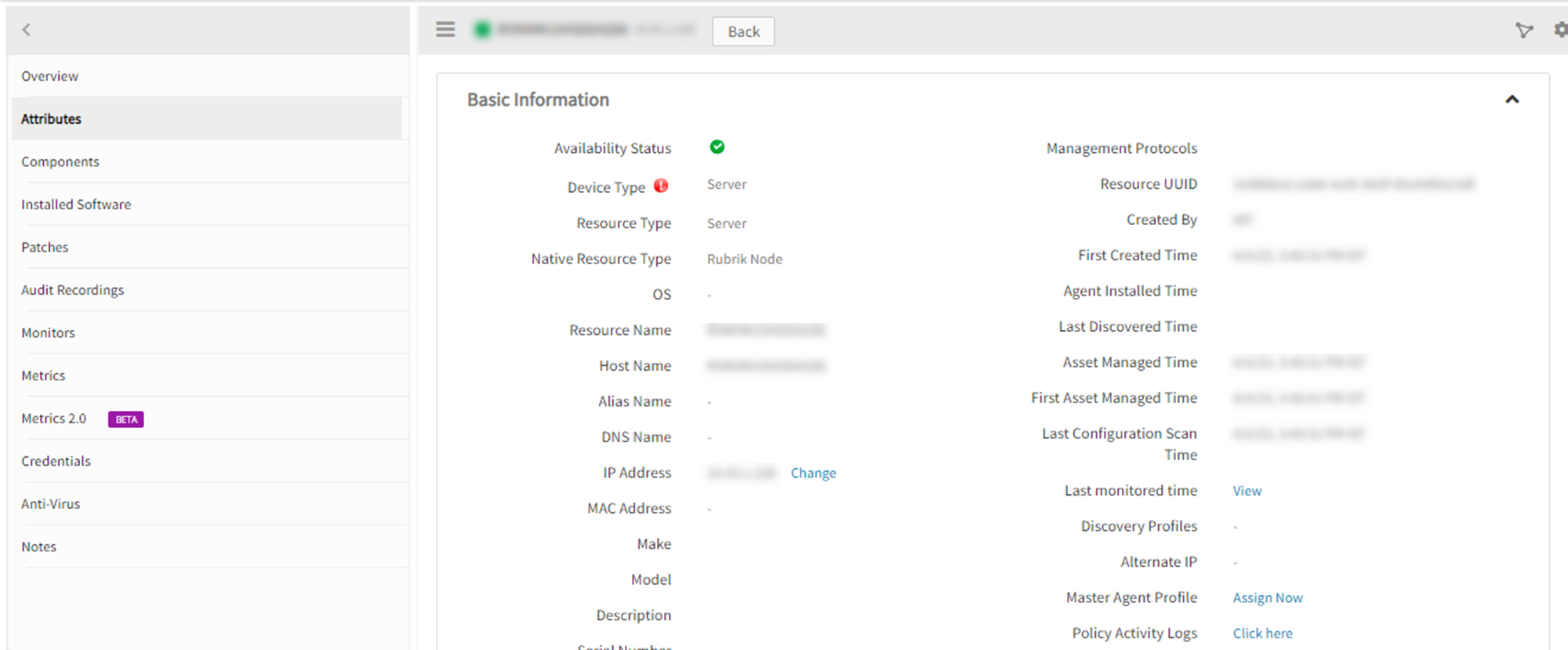| Supported Target Version |
|---|
| Rubrik cluster software version: 8.0.2-p2-22662 |
Application Version and Upgrade Details
| Application Version | Bug fixes / Enhancements |
|---|---|
| 2.0.2 | Added support for NativeType Display order changes and resource grouping by type in UI |
| 2.0.3 | Bug Fix for metrics intermittent issue |
| 2.0.1 |
|
Click here to view the earlier version updates
| Application Version | Bug fixes / Enhancements |
|---|---|
| 2.0.0 |
|
| 1.0.0 | Initial SDK2.0 app Discovery and Monitoring Implementations. |
Introduction
Rubrik simplifies backup and recovery for hybrid cloud environments. By combining data orchestration, catalog management, and deduplicated storage into a singular software platform, it removes the complexity of legacy backup systems. Enterprises can use Rubrik’s API-first software tool to automate automation and unlock cloud for long-term data retention or disaster recovery. Rubrik supports the top operating systems, databases, hypervisors, clouds, and SaaS apps and was made to be vendor-neutral.
Rubrik assists organizations in maintaining data integrity, provides data availability that withstands challenging circumstances, constantly tracks data risks and threats, and restores businesses with their data when infrastructure is attacked.
Key Use cases
Discovery Use cases
- It discovers the Rubrik Cluster components.
- Publishes relationships between resources to have a topological view and ease of maintenance.
Monitoring Use cases
- Provides metrics related to job scheduling time and status etc,.
- Generates alerts for each metric and notifies administrators about the issue with the resource.
Prerequisites
- OpsRamp Classic Gateway 14.0.0 and above.
- OpsRamp NextGen Gateway 14.0.0 and above.
Note: OpsRamp recommends using the latest Gateway version for full coverage of recent bug fixes, enhancements, etc. - Provided IpAddress/hostname, credentials should work for Rubrik REST API’s.
Hierarchy of Rubrik resources
- Rubrik Cluster
- Rubrik Node
- Rubrik Disk
Supported Metrics
Click here to view the supported metrics
| Native Type | Metric Names | Display Name | Unit | Application Version | Description |
|---|---|---|---|---|---|
| Rubrik Cluster | rubrik_cluster_runwayRemaining | Rubrik Cluster Runway Remaining | Days | 1.0.0 | Number of days remaining before the system fills up. |
| rubrik_cluster_Status | Rubrik Cluster Status | 1.0.0 | Status of the Rubrik cluster. | ||
| rubrik_cluster_StorageUsage | Rubrik Cluster Storage Usage | GB | 1.0.0 | Used storage of the Rubrik cluster. | |
| rubrik_cluster_StorageUtilization | Rubrik Cluster Storage Utilization | % | 1.0.0 | Storage utilization of the Rubrik cluster. | |
| rubrik_cluster_PhysicalDataIngestion | Rubrik Cluster Physical Data Ingestion | Bytes/sec | 1.0.0 | Physical data ingestion of the Rubrik cluster. | |
| rubrik_cluster_ReadIOPS | Rubrik Cluster Read IOPS | IOPS | 1.0.0 | Read IOPS of Rubrik cluster. | |
| rubrik_cluster_WriteIOPS | Rubrik Cluster Write IOPS | IOPS | 1.0.0 | Write IOPS of Rubrik cluster. | |
| rubrik_cluster_ReadIOThroughput | Rubrik Cluster Read IO Throughput | Bytes/sec | 1.0.0 | ReadIO throughput statistics of Rubrik cluster. | |
| rubrik_cluster_WriteIOThroughput | Rubrik Cluster Write IO Throughput | Bytes/sec | 1.0.0 | WriteIO throughput statistics of Rubrik cluster. | |
| rubrik_task_SuccessCount | Rubrik Task Success Count | count | 1.0.0 | Success count of tasks on Rubrik cluster. | |
| rubrik_task_FailureCount | Rubrik Task Failure Count | count | 1.0.0 | Failure count of tasks on Rubrik cluster. | |
| rubrik_job_SuccessCount | Rubrik Job Success Count | count | 1.0.0 | Success count of jobs run in the last 24 hours. | |
| rubrik_job_FailureCount | Rubrik Job Failure Count | count | 1.0.0 | Failure count of jobs run in the last 24 hours. | |
| rubrik_job_ActiveCount | Rubrik Job Active Count | count | 1.0.0 | Active jobs running for the last 24 hours. | |
| rubrik_job_CanceledCount | Rubrik Job Canceled Count | count | 1.0.0 | Canceled jobs in the last 24 hours. | |
| rubrik_cluster_RegisteredHostStatus | Rubrik Cluster Registered Host Status | 1.0.0 | Connection status of hosts registered to Rubrik cluster. | ||
| rubrik_resource_APIStats | Rubrik API Statistics | count | 2.0.0 | Provides the number of API calls and resources made within the frequency. | |
| rubrik_event_Statistics | Rubrik Event Statistics | 1.0.0 | Provides the count of the number of events polled within the frequency | ||
| Rubrik Node | rubrik_node_Status | Rubrik Node Status | 1.0.0 | Status of the Rubrik cluster node. | |
| rubrik_node_ReadIOPS | Rubrik Node Read IOPS | IOPS | 1.0.0 | Rubrik cluster node read IOPS. | |
| rubrik_node_WriteIOPS | Rubrik Node Write IOPS | IOPS | 1.0.0 | Rubrik cluster node write IOPS. | |
| rubrik_node_ReadIOThroughput | Rubrik Node Read IO Throughput | Bytes/sec | 1.0.0 | Rubrik cluster node read IO throughput. | |
| rubrik_node_WriteIOThroughput | Rubrik Node Write IO Throughput | Bytes/sec | 1.0.0 | Rubrik cluster node write IO throughput. | |
| Rubrik Disk | rubrik_disk_Status | Rubrik Disk Status | 1.0.0 | Status of the Rubrik cluster node disk. | |
| rubrik_disk_Usage | Rubrik Disk Usage | GB | 1.0.0 | Rubrik cluster node disk usage. | |
| rubrik_disk_Utilization | Rubrik Disk Utilization | % | 1.0.0 | Rubrik cluster node disk utilization. |
Default Monitoring Configurations
Rubrik has default Global Device Management Policies, Global Templates, Global Monitors and Global metrics in OpsRamp. You can customize these default monitoring configurations as per your business use cases by cloning respective Global Templates and Global Device Management Policies. OpsRamp recommends performing the below activity before installing the application to avoid noise alerts and data.
Default Global Device Management Policies
OpsRamp has a Global Device Management Policy for each Native Type of Rubrik Cluster. You can find those Device Management Policies at Setup > Resources > Device Management Policies, search with suggested names in global scope. Each Device Management Policy follows below naming convention:
{appName nativeType - version}Ex: rubrik Rubrik Cluster - 1 (i.e, appName = rubrik, nativeType =Rubrik Cluster, version = 1)
Default Global Templates
OpsRamp has a Global template for each Native Type of Rubrik Cluster. You can find those templates at Setup > Monitoring > Templates, search with suggested names in global scope. Each template follows below naming convention:
{appName nativeType 'Template' - version}Ex: rubrik StorageGRID Template - 1 (i.e, appName = rubrik , nativeType = Rubrik Cluster, version = 1)
Default Global Monitors
OpsRamp has a Global Monitors for each Native Type which has monitoring support. You can find those monitors at Setup > Monitoring > Monitors, search with suggested names in global scope. Each Monitors follows below naming convention:
{monitorKey appName nativeType - version}Ex: Rubrik Cluster Monitor rubrik Rubrik Cluster 1 (i.e, monitorKey = Rubrik Cluster Monitor, appName = rubrik , nativeType = Rubrik Cluster, version= 1)
Configure and Install the Rubrik Integration
- From All Clients, select a client.
- Navigate to Setup > Account.
- Select the Integrations and Apps tab.
- The Installed Integrations page, where all the installed applications are displayed. If there are no installed applications, it will navigate to the Available Integrations and Apps page.
- Click + ADD on the Installed Integrations page. The Available Integrations and Apps page displays all the available applications along with the newly created application with the version.
Note: Search for the application using the search option available. Alternatively, use the All Categories option to search.

- Click ADD in the Rubrik application.
- In the Configuration page, click + ADD. The Add Configuration page appears.
- Enter the below mentioned BASIC INFORMATION:
| Functionality | Description |
|---|---|
| Name | Enter the name for the configuration. |
| Rubrik Cluster IP Address/Host Name | Enter the Host name or the IP address. |
| Rubrik REST API Port | API Port information |
| Credential | Select the credentials from the drop-down list. Note: Click + Add to create a credential. |
Notes:
- By default the Is Secure checkbox is selected.
- Rubrik Cluster IP Address/Host Name and Rubrik REST API Port should be accessible from Gateway.
- Select the following:
- App Failure Notifications: if enabled,
- an alert will be sent to the registered gateway resource.
- an alert is raised for connectivity, authentication exception,
- Discovery - alert will be on a gateway resource that is registered with the application.
- Monitoring - alert will be on a particular Powerflex resource.
- Alert Configuration: enables integrating third party alerts into OpsRamp using further configurations.
- App Failure Notifications: if enabled,
- Below are the default values set for:
- alertSeverity: provides severity alerts that get integrated out of all possible alerts.
- Default Values: Critical, Warning.
- Possible Values: Critical, Warning.
- Alert Severity Mapping: enables you to map the severities between Dell PowerFlex and OpsRamp as severities are predefined values in each system.
- Possible values of Alert Severity Mapping Filter configuration property are {“Critical”:“Critical”,“Warning”:“Warning”}
Note: You can change it as per your business use cases at any point in time from the Configuration page.
- Possible values of Alert Severity Mapping Filter configuration property are {“Critical”:“Critical”,“Warning”:“Warning”}
- alertSeverity: provides severity alerts that get integrated out of all possible alerts.
- Select the below mentioned Custom Attribute:
| Functionality | Description |
|---|---|
| Custom Attribute | Select the custom attribute from the drop down list box. |
| Value | Select the value from the drop down list box. |
Note: The custom attribute that you add here will be assigned to all the resources that are created by the integration. You can add a maximum of five custom attributes (key and value pair).
- In the RESOURCE TYPE section, select:
- ALL: All the existing and future resources will be discovered.
- SELECT: You can select one or multiple resources to be discovered.
- In the DISCOVERY SCHEDULE section, select Recurrence Pattern to add one of the following patterns:
- Minutes
- Hourly
- Daily
- Weekly
- Monthly
- Click ADD.

Now the configuration is saved and displayed on the configurations page after you save it.
Note: From the same page, you may Edit and Remove the created configuration.
- Click Next.
- Below are the optional steps you can perform on the Installation page.
Under the ADVANCED SETTINGS, Select the Bypass Resource Reconciliation option, if you wish to bypass resource reconciliation when encountering the same resources discovered by multiple applications.
Note: If two different applications provide identical discovery attributes, two separate resources will be generated with those respective attributes from the individual discoveries.

- Click +ADD to create a new collector by providing a name or use the pre-populated name.

- Select an existing registered profile.

- Click FINISH.
The integration is now installed and displayed on the Installed Integration page. Use the search field to find the installed application.
Modify the Configuration
See Modify an Installed Integration or Application article.
Note: Select the Rubrik application.
View the Rubrik details
The discovered resource(s) are displayed in Infrastructure > Resources > Server, with Native Resource Type as Rubrik Node. You can navigate to the Attributes tab to view the discovery details, and the Metrics tab to view the metric details for Rubrik Node.


Resource Type Filter Keys
Rubrik application resources are filtered and discovered based on below keys:
Click here to view the Supported Input Keys
| Resource Type | Supported Input Keys |
|---|---|
| All Types | resourceName |
| hostName | |
| aliasName | |
| dnsName | |
| ipAddress | |
| macAddress | |
| os | |
| make | |
| model | |
| serialNumber | |
| Rubrik Cluster | Version |
| API Version | |
| Registered Mode | |
| Timezone | |
| Rubrik Disk | Disk Type |
| Node Id | |
| path | |
| Rubrik Node | BrikId |
Risks, Limitations & Assumptions
- Application can handle Critical/Recovery failure notifications for below two cases when user enables App Failure Notifications in configuration
- Connectivity Exception
- Authentication Exception
- Application will not send any duplicate/repeat failure alert notification until the already existing critical alert is recovered.
- Using metrics for monitoring the resources and generating alerts when the threshold values are breached.
- Application cannot control monitoring pause/resume actions based on above alerts.
- No support of showing activity log and applied time.
- Event polling Critical alerts generated based on “event_series_status” category “Failure” events.
- Coming to the challenge with event monitoring, we could not relate a Failure event with a subsequent heel event. So because of this there won’t be any healing mechanism from the application side. The customer has to heal the alerts manually in every case.
- This application supports both Classic Gateway and NextGen Gateway.